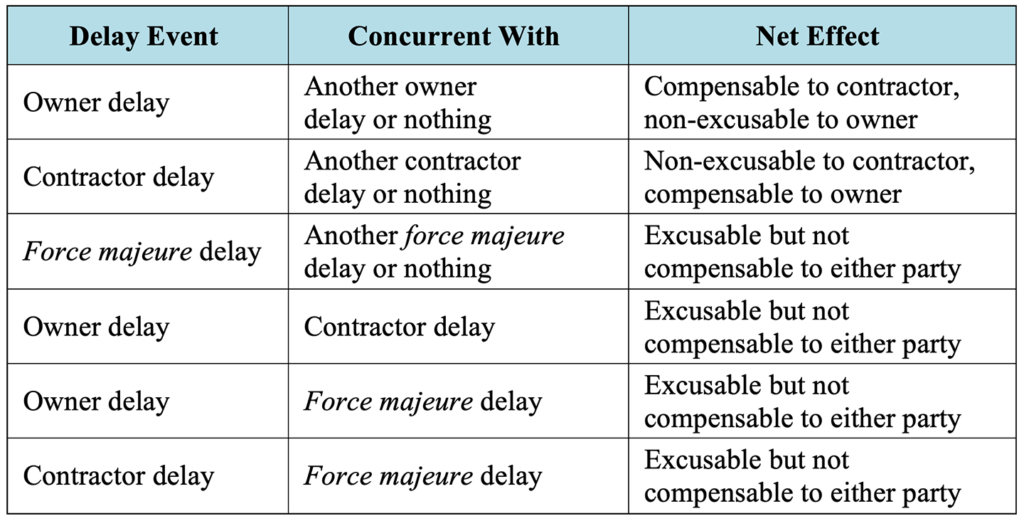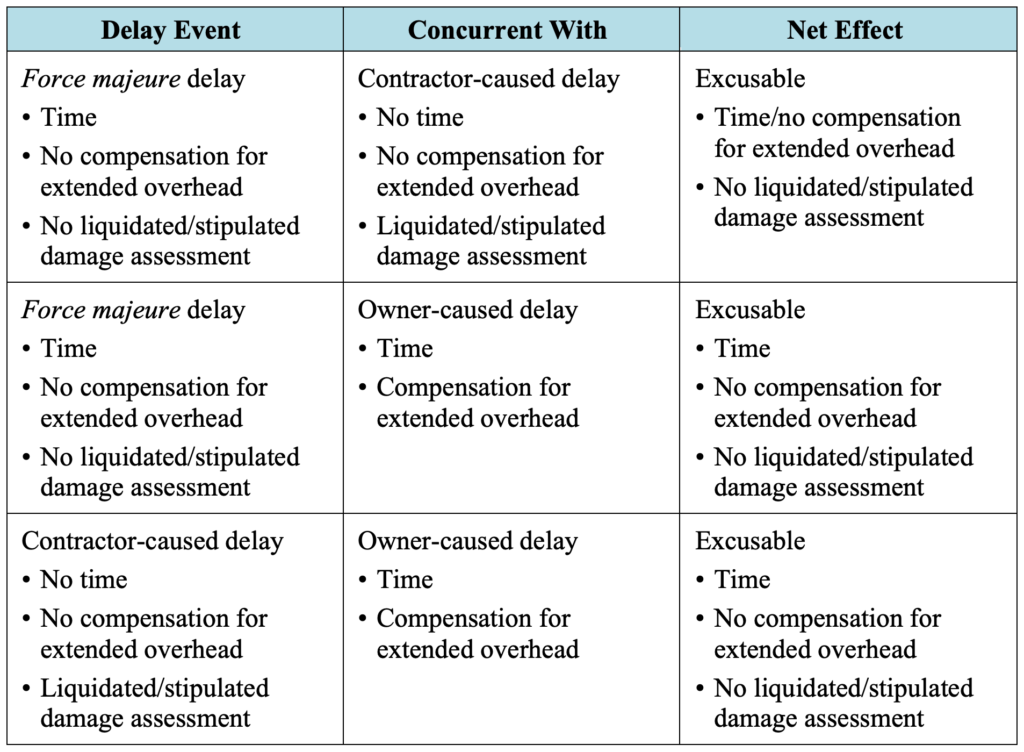
November 7, 2022
Concurrent Delay Liability and Damages
This is the second of two blog posts examining concurrent delay. In situations of concurrent delay, the contract between the parties must first be examined to determine whether it indicates how to consider the allocation of liability for any concurrent delay without sophisticated analysis.
The contract may provide no direct guidance as to the treatment of concurrent delay. However, certain contracts may be more explicit, stating that neither party is to receive compensation when delays are concurrent. Some contracts go further and state that when concurrent delay occurs, not only is no delay compensation available to either party, but the contractor is not entitled to a time extension. The latter would be an unusual provision for which the contractor may be accepting significant risk if liquidated damages for delay also apply in the event of setbacks to the project.
Notwithstanding the aforementioned problem, if no contractual provision states otherwise, the most commonly applied principle applied in the international construction industry is that if the owner-caused and contractor-caused delays are concurrent and of equal duration, and if they equally affected the critical path to project completion or another milestone date, the contractor would not be entitled to compensable delay damages and the owner would not be entitled to its actual delay or liquidated damages.
In such cases, there is usually no requirement that concurrent delays be equally critical. In addition, it also follows that non-critical delays can be used to offset compensable delay on a day‑for-day basis after the calculation of relative float is determined for the critical and near-critical paths. Thus, if one delay occurs on an activity path, and a parallel activity path experiences another delay, but the two activity paths have different float values, then the number of concurrent delay days is calculated after considering the float difference between the two activities.
The various permutations of concurrent delay are summarized in Table 1, outlining the net effect of concurrent liabilities, including liquidated damages for delay, in different scenarios.
Table 1
Concurrent Delay Scenarios and Net Effect

Legal jurisdictions around the world differ as to the treatment of the liability and damages aspects of concurrent delay. Common legal applications of time extension and cost recovery entitlement are summarized in Table 2.
Table 2
Concurrent Delay Combinations and Net Effect

Factors that influence the identification and quantification of concurrent delay include the following:
- Whether concurrency is determined literally or functionally;
- Whether concurrency is determined on the cause or the effect of delay;
- The frequency, duration, and placement of the analysis interval;
- The order of delay insertion or extraction in a stepped implementation; and
- Whether the analysis is done using full hindsight or based on knowledge at the time.
The parties must first be guided by the provisions in their contract or referenced documents regarding the handling of time extensions, concurrent delay, excusable delay, compensable delay, and liquidated damages. If the contract or referenced documents do not include specific provisions regarding these issues, the following practical guidelines with respect to dealing with these issues are provided:
- Use a windows-based CPM schedule analysis to determine if the contractor is entitled to a time extension as a result of excusable delays to the then critical path of the project at the time that the excusable delays occurred.
- If the actual project delay is greater than the amount of time extension to which the contractor is entitled, then the owner may be entitled to receive liquidated damages, or actual damages if no liquidated damages are stated in the contract for the additional contractor-caused delays.
- Use a windows-based CPM schedule analysis to determine if the contractor is entitled to additional compensation for time-related costs as a result of compensable delays to the then critical path of the project at the time that the compensable delays occurred.
- If the contractor can demonstrate that it was effectively delayed by an owner-responsible event and the owner can demonstrate that the project was also concurrently delayed by an event that was caused by the contractor or actions for which the contractor is responsible, the contractor may nevertheless be entitled to an extension of time for the full amount of such owner-responsible delay unless otherwise stated in the contract between the parties.
- In considering whether owner-responsible events have also “caused” the project delay, the principles of causation should be examined, and certain causes of delay that, while sequential or parallel, are not of equal causative persuasion, may need to be excluded. If the occurrence of an owner event is merely coincidental and simply provides a slippage to minor work rather than the true cause for the project delay, there may be no extension of time entitlement and the owner may be entitled to liquidated or actual damages.
- In considering whether contractor-caused events or actions for which the contractor is responsible have also “caused” the project delay, the principles of causation should also be examined, and certain causes of delay that, while sequential or parallel, are not of equal causative persuasion, may need to be excluded. If the occurrence of a contractor-caused event is merely coincidental and simply provides a slippage to minor work rather than the true cause for the project delay, there may be no liquidated damages entitlement and the contractor may be entitled to its time-related costs for the period of delay.
- If it is established that the cause of the delay is attributable to the owner (i.e., there is no true concurrent delay), and if the contractor has complied with the notice provisions and the duty to mitigate any delay, the amount of time extension and/or the reimbursement of the contractor’s time-related costs should be dealt with pursuant to the Change Orders clause or other contractual provisions, and if not agreed on, dealt with pursuant to the Dispute Resolution and Arbitration clause.
- If functional or literal concurrent delay arises, subject to a CPM schedule analysis to otherwise allocate delay, the contractor may be entitled to a time extension for the period of the concurrent delay, but no time-related costs for that period unless otherwise stated in the contract.
For a more detailed discussion of concurrent delay, see Richard J. Long’s article, “Analysis of Concurrent Delay on Construction Claims.”
ADDITIONAL RESOURCES

Blog
Discover industry insights on construction disputes and claims, project management, risk analysis, and more.
MORE

Articles
Articles by our engineering and construction claims experts cover topics ranging from acceleration to why claims occur.
MORE

Publications
We are committed to sharing industry knowledge through publication of our books and presentations.
MORE
Recommended Reads
Analysis of Concurrent Delay on Construction Claims
This article addresses treatment of concurrent delay in various legal jurisdictions, allocation of delay responsibility when concurrent delay occurs, pacing vs. concurrent delay, and more.
READ
Concurrent Delay Defined
This is the first of two blog posts examining concurrent delay, a vexed and complex technical and legal issue.
READ
Construction Claim Types for Contractors
U.S. federal and state courts recognize 19 basic construction claim entitlements for a contractor’s recovery of damages. This post is the first of a series discussing each of these 19 types.
READ

